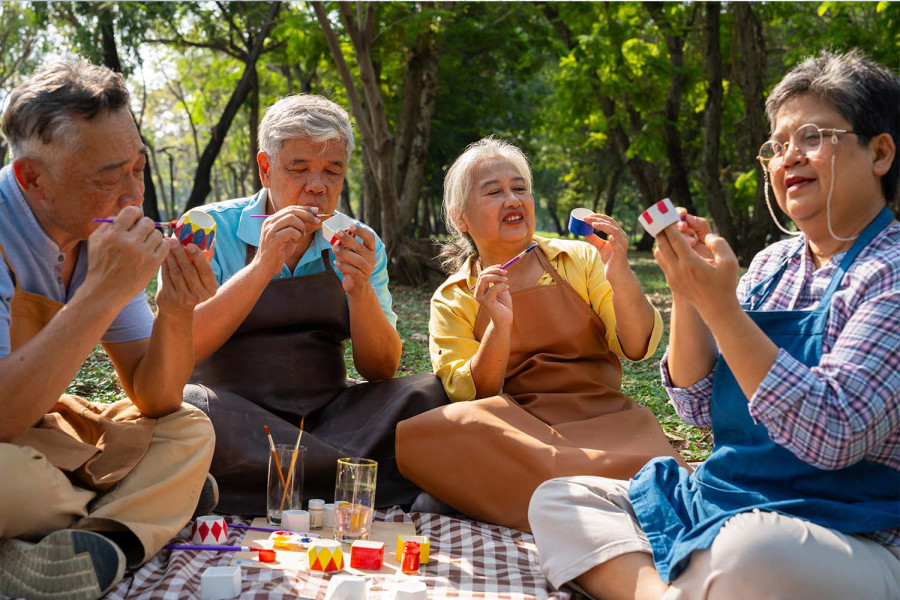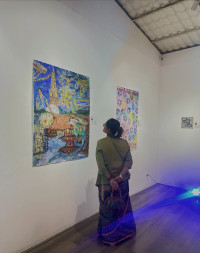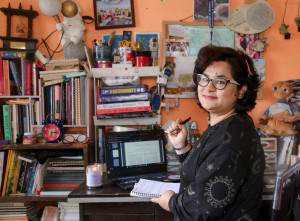Culture & Lifestyle
Art therapy for the elderly
This therapy keeps elderly people mentally active, providing a platform for self-expression.
Timila Maharjan
The mental health of elderly people remains one of the most under-discussed topics. As people age, their mental health needs evolve, requiring tailored approaches to maintain psychological well-being. Art therapy effectively keeps elderly people mentally active, providing a platform for self-expression, emotional exploration, and cognitive stimulation.
Lajja Dixit, an art therapist and private practitioner, discusses the benefits of art therapy for elderly people.
What is art therapy, and how does it differ from other forms?
Art therapy is a form of psychotherapy that uses visual images as the primary mode of communication. The process involves using materials to help clients express their innermost feelings and thoughts without using words. The approach to this form of therapy can be eclectic, using various modes of intervention, such as psychoanalytical, humanistic, narrative, developmental, cognitive-behavioural, solution-focused, and multimodal. The technique chosen will depend on the client’s issues, situation, needs, and history.
Other forms of expressive therapy, like drama, music, and play, also have their own effectiveness and creative forms. However, with art therapy, the physical medium used in the process, such as drawings, paintings, sculptures, and collages, helps to understand the client’s progress. The beauty of this kind of therapy lies in the client’s direct contact with the materials used, allowing them to ‘see and feel’ while they immerse themselves in the healing process.
How can elderly individuals benefit from this therapy?
Creative practices are great for focus, memory, and problem-solving. One of the biggest strengths of such therapy is self-awareness. The creative aspect allows older individuals to understand themselves and focus on their abilities and strengths. Consistent sessions give them a sense of purpose, which could be lacking in professionals who lead retired or solitary lives. Visual materials can also give them a sense of control, which could help their self-esteem.
Can art therapy help in treating dementia?
Yes, it can manage the quality of life of people with dementia. The process of art-making can help to engage and communicate. Furthermore, such therapies have proven to be relaxing, which helps with abstract thinking, building attentional capacity, and improving motor skills.
A sense of purpose has proven to help people with dementia. Consistency in image-making and visual expressions provides opportunities for self-expression, which helps boost confidence.
Are there specific art activities that improve motor skills or coordination for elderly participants?
Engaging in creative activities can improve motor skills and hand-eye coordination. The use of finger-painting, drawing, clay-work and even
the use of tools like scissors help them with their motor skills.
Materials like clay or softer playdough allow them to relax. Anything that incorporates smaller movements can be relaxing and effective.
What low-cost or simple art activities can be done at home or in community settings?
Building collages using scrap paper is a good way to bring people together. Similarly, having story-telling sessions using visuals or objects depicting their own lives is an effective way to communicate via conversations. Using everyday material like flour to make the homemade dough is a good option. Similarly, using fallen leaves or petals to create art on the ground is a great way to engage with nature and express oneself. Art therapy does not require expensive materials. The idea is to express oneself using visual mediums.

What changes do you observe in elderly clients through consistent participation in art therapy?
With my experience working with older clients, I have concluded that art therapy helps enhance the quality of life, making clients self-sufficient, confident, and active. Therapy is a slow process, and we cannot expect results overnight, but with regular sessions, clients have gone from being lonely and irritable to confident and content.
As said earlier, the therapy process allows them to express themselves, giving them the space to understand what triggers them. This finding allows them to find a purpose by honing their abilities and strengths. Therapy gives them a sense of empowerment.
How does this therapy influence the quality of life?
This therapy improves the quality of life by fostering self-understanding and self-belief. It encourages individuals, particularly the elderly, to express their feelings, filter out external stressors, and focus on their well-being. The therapy promotes a healthier and more fulfilling lifestyle by building confidence and motivating them to re-engage in activities they once enjoyed. Combining art-making with meaningful conversations generates positive emotions, creating a foundation for a happier, more vibrant life.
How common is art therapy in Nepal, especially for the elderly?
In my experience, art therapy has become much more sought after than it once was. The stigma around visiting a mental health practitioner seems to be diminishing. Over the past few years, I have frequently worked with clients aged 70 to 82. The freedom of expression that creative methods provide is often more effective than words. Moreover, art therapy can be an eye-opener, encouraging clients to use therapeutic tools to heal.
At its core, everyone needs a way to express their feelings. When words fail, creative methods offer a powerful alternative. I am heartened to see art therapy paving the way for self-care and delivering positive results for many people.




 13.12°C Kathmandu
13.12°C Kathmandu















